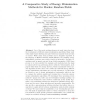Free Online Productivity Tools
i2Speak
i2Symbol
i2OCR
iTex2Img
iWeb2Print
iWeb2Shot
i2Type
iPdf2Split
iPdf2Merge
i2Bopomofo
i2Arabic
i2Style
i2Image
i2PDF
iLatex2Rtf
Sci2ools
ECCV
2006
Springer
2006
Springer
A Comparative Study of Energy Minimization Methods for Markov Random Fields
One of the most exciting advances in early vision has been the development of efficient energy minimization algorithms. Many early vision tasks require labeling each pixel with some quantity such as depth or texture. While many such problems can be elegantly expressed in the language of Markov Random Fields (MRF's), the resulting energy minimization problems were widely viewed as intractable. Recently, algorithms such as graph cuts and loopy belief propagation (LBP) have proven to be very powerful: for example, such methods form the basis for almost all the top-performing stereo methods. Unfortunately, most papers define their own energy function, which is minimized with a specific algorithm of their choice. As a result, the tradeoffs among different energy minimization algorithms are not well understood. In this paper we describe a set of energy minimization benchmarks, which we use to compare the solution quality and running time of several common energy minimization algorithms....
Common Energy Minimization | Computer Vision | ECCV 2006 | Efficient Energy Minimization | Energy Minimization Algorithms | Energy Minimization Benchmarks | Energy Minimization Problems |
Related Content
| Added | 16 Oct 2009 |
| Updated | 16 Oct 2009 |
| Type | Conference |
| Year | 2006 |
| Where | ECCV |
| Authors | Richard Szeliski, Ramin Zabih, Daniel Scharstein, Olga Veksler, Vladimir Kolmogorov, Aseem Agarwala, Marshall F. Tappen, Carsten Rother |
Comments (0)

